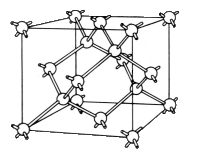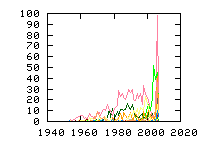Showing
10, 25, 50, 100, 500, 1000, all papers per page.
Sort by:
last publication date,
older publication date,
last update date.
- 1. Phys. Rev. 133, A1163 (1964) , “Optical Properties of Cubic SiC: Luminescence of Nitrogen-Exciton Complexes, and Interband Absorption”, W. J. Choyke, D. R. Hamilton, and Lyle PatrickAbsorption measurements of cubic SiC at 4.2?K show that the absorption edge is due to indirect, exciton-creating transitions, with an exciton energy gap of 2.390 eV. The energies of the phonons participating in these transitions are 46, 79, 94, and 103 meV, and suggest that the conduction-band... (Read more)
- 2. J. Vac. Sci. Technol. 9, 87-90 (1972) , “Properties of ZnO Films Prepared by dc and rf Diode Sputtering”, J. VuillodA brief description of the dc and rf diode sputtering unit is first presented. The study of properties of the films is reviewed taking into consideration two main parameters, oxygen partial pressure and substrate temperature. Reflection electron diffraction and x-ray diffraction studies show that... (Read more)
- 3. J. Lumin. 5, 385-405 (1972) , “Trapping and recombination processes in the thermoluminescence of Li-doped ZnO single crystals*1”, D. ZwingelThe thermoluminescence of Li-doped ZnO single crystals is investigated in the temperature range 4.2–300 K. A glow curve is observed with three maxima, two of them emitting the strong polarized yellow luminescence of ZnO. By varying the Li concentration in the range 0.1–200 ppm a change... (Read more)
- 4. Solid State Commun. 14, 45-49 (1974) , “Paramagnetic and optical properties of Na-doped ZnO single crystals”, D. Zwingel and F. GärtnerESR-spectra of Na-doped ZnO single crystals are reported, caused by a hole trapped at the Na+ center. The isotropic part of the HFS is positive. An emission, due to recombination at the center, is reported, polarized c and peaked at 570 nm. The influence of covalent bonding is discussed. (Read more)
- 5. Solid State Commun. 15, 1475-1479 (1974) , “Optical and paramagnetic properties of ZnO-Crystals simultaneously doped with copper and hydrogen”, E. Mollwo, G. Müller and D. ZwingelIn ZnO crystals, containing both Cu and H(D), we observe characteristic absorption peaks in the near i.r. and three new EPR signals. We explain these results by the formation of impurity complexes consisting of an OH center and one or two Cu ions. (Read more)
- 6. Z. Physik B 23, 171-181 (1976) , “Intrinsic Defects in Electron Irradiated Zinc Oxide”, B. Schallenberge, A. Hausmann
- 7. phys. stat. sol. (a) 55, 251 (1979) , “Photo-EPR of Dislocations in Silicon”, R. Erdmann, H. Alexander.The dependence of the EPR spectrum of dislocations in deformed silicon on illumination with monochromatic light reveals the two EPR centers Si - K1 (S < 1/2) to be different ionization states of one and the same dislocation center. The energy level separating these ionization states lies near the... (Read more)
- 8. J. Non-Cryst. Solids 34, 339-356 (1979) , “ESR and optical absorption of cupric ion in borate glasses”, H. Hosono, H. Kawazoe and T. KanazawaESR and optical absorption of Cu2+ were measured in xNa2O(100−x)B2O3 (1 ≤ x ≤ 75), x ZnO(100−x)B2O3 (46 ≤ x ≤ 64) and x Pb(100−x)b2O3 (20 ≤ x ≤ 75) glasses, where x is expressed in mol.%. Spin hamiltonian parameters and ligand field... (Read more)
- 9. Phys. Rev. Lett. 51, 423 (1983) , “Creation of Quasistable Lattice Defects by Electronic Excitation in SiO2”, Katsumi Tanimura, Takeshi Tanaka, and Noriaki ItohThe transient volume change of ?-quartz and fused silica induced by irradiation with an electron pulse has been measured above 80 K. It is shown that transient changes of volume and optical absorption due to the E1? centers (oxygen vacancies) decay in parallel and that the... (Read more)
- 10. Appl. Phys. Lett. 44, 228-230 (1984) , “Optically induced electron spin resonance and spin-dependent recombination in Si/SiO2”, B. HendersonIn state-of-the-art Si/SiO2 wafers the concentration of paramagnetic interface states (1010 cm–2) is almost too low to be detected by electron spin resonance (ESR). This letter describes experiments which show that the ESR signal of singly occupied dangling bond... (Read more)
- 11. J. Non-Cryst. Solids 116, 289-292 (1990) , “Bleaching of peroxy radical in SiO2 glass with 5 eV light*1”, H. Hosono, R. A. WeeksPeroxy radical (POR) in SiO2 glass has been found to be bleached out by illumination with 5 eV light without accompanying changes in E′ and non-bridging oxygen hole centers. An absorption band centered at 4.8 eV (FWHM; ≈ 0.8 eV is also bleached together with POR. It is suggested that... (Read more)
- 12. J. Non-Cryst. Solids 179, 39-50 (1994) , “Paramagnetic resonance of E′-type centers in Si-implanted amorphous SiO2. Si29 hyperfine structure and characteristics of Zeeman resonances*1”, H. Hosono, H. Kawazoe, K. Oyoshi, S. TanakaElectron paramagnetic resonance spectra were measured on SiO2 glasses implanted with Si ions to a fluence of 6 × 1016 cm−2 at an acceleration voltage of 160 kV. Three sets of doublets with different separation were observed in Si29-implanted substrates and were ascribed to primary... (Read more)
- 13. Appl. Phys. Lett. 67, 1280 (1995) , “Impact of Pb doping on the optical and electronic properties of ZnO powders”, K. Vanheusden, W. L. Warren, J. A. Voigt, C. H. Seager, and D. R. TallantElectron paramagnetic resonance (EPR), optical absorption, and photoluminescence (PL) spectroscopy have been combined to characterize Pb-doped ZnO ceramic powders. We observe a decrease in the 2.26 eV emission peak and a concomitant smearing of the band edges, narrowing the effective gap of the... (Read more)
- 14. Radiat. Meas. 26, 131-137 (1996) , “Effect of oxide additives on radiolytic decomposition of zirconium and thorium nitrates”, N. G. Joshi, A. N. Garg, V. Natarajan and M. D. SastryGamma ray-induced decomposition of the binary mixtures of zirconium and thorium nitrates with 2.5, 5 and 10 mol% of V2O5, PbO, ThO2, ZrO2, and MnO2 has been studied at different doses up to 260 kGy. Radiation chemical yield G(NO2−)-values are enhanced by V2O5, PbO, and ThO2 but are decreased... (Read more)
- 15. J. Appl. Phys. 79, 7983-7990 (1996) , “Mechanisms behind green photoluminescence in ZnO phosphor powders”, K. Vanheusden, W. L. Warren, C. H. Seager, D. R. Tallant, J. A. Voigt, B. E. GnadeWe explore the interrelationships between the green 510 nm emission, the free-carrier concentration, and the paramagnetic oxygen-vacancy density in commercial ZnO phosphors by combining photoluminescence, optical-absorption, and electron-paramagnetic-resonance spectroscopies. We find that the green... (Read more)
- 16. Appl. Phys. Lett. 68, 403 (1996) , “Correlation between photoluminescence and oxygen vacancies in ZnO phosphors”, K. Vanheusden, C. H. Seager, W. L. Warren, D. R. Tallant, and J. A. VoigtBy combining electron paramagnetic resonance (EPR), optical absorption, and photoluminescence (PL) spectroscopy, a strong correlation is observed between the green 510 nm emission, the free-carrier concentration, and the density of singly ionized oxygen vacancies in commercial ZnO phosphor powders.... (Read more)
- 17. phys. stat. sol. (a) 162, 95-151 (1997) , “EPR and ENDOR Investigations of Shallow Impurities in SiC Polytypes”, S. Greulich-WeberInvestigations of nitrogen donors in 6H-, 4H- and 3C-SiC using conventional electron paramagnetic resonance (EPR), electron nuclear double resonance (ENDOR) and optical detection of EPR and ENDOR as well as optical absorption and emission spectroscopy are reviewed and critically discussed. An... (Read more)
- 18. Phys. Rev. Lett. 80, 317-320 (1998) , “Experimental Evidence for Frenkel Defect Formation in Amorphous SiO2 by Electronic Excitation”, H. Hosono, H. Kawazoe, N. MatsunamiConcentrations of defects in amorphous SiO2 created by implantation of 10 MeV protons were examined. The depth profile of Si-Si bonds, E? centers, or peroxy radicals (PORs) was close to that of electronic energy loss. Interstitial O2 molecules were identified and... (Read more)
- 19. Nucl. Instrum. Methods Phys. Res. B 141, 566-574 (1998) , “Defect formation in amorphous SiO2 by ion implantation: Electronic excitation effects and chemical effects”, H. Hosono, N. MatsunamiIntrinsic defect formation in amorphous (a-) SiO2 by ion implantation was examined with emphasis upon electronic excitation effects and chemical reaction effects. 10 MeV proton beam and boron beam irradiated silica platelets to examine electronic excitation effects and chemical reaction effects. In... (Read more)
- 20. J. Non-Cryst. Solids 239, 16-48 (1998) , “Optically active oxygen-deficiency-related centers in amorphous silicon dioxide”, Linards SkujaThe spectroscopic properties, structure and interconversions of optically active oxygen-deficiency-related point defects in vitreous silica are reviewed. These defects, the E′-centers (oxygen vacancies with a trapped hole or 3-fold-coordinated silicons), different variants of diamagnetic... (Read more)GeO2 SiO2| EPR PL gamma-irradiation optical-spectroscopy| 0.5-1.0eV 1.0eV~ 1H 2.0eV~ 3.0eV~ 4.0eV~ 5.0eV~(larger) Chlorine E' E'-alpha E'-betha E'-delta E'-gamma Germanium H(I) H(II) Hydrogen ODC ODC(I) ODC(II) OHC Oxygen POR Silicon amorphous dangling-bond dielectric interstitial pair(=2) surface triplet vacancy | last update: Takahide Umeda
- 21. Phys. Rev. B 59, 12900 (1999) , “Electron-paramagnetic-resonance measurements on the divacancy defect center R4/W6 in diamond”, D. J. Twitchen, M. E. Newton, J. M. Baker, T. R. Anthony, W. F. BanholzerElectron-paramagnetic-resonance (EPR) studies in radiation damaged diamond enriched to 5% 13C have resulted in the identification of the nearest-neighbor divacancy center. It is the isotopic enrichment, and consequent observation of 13C hyperfine lines, that has permitted the... (Read more)
- 22. Mater. Res. Soc. Symp. Proc. 573, 107 (1999) , “ELECTRICAL AND OPTICAL STUDY OF CHARGE TRAPS AT PASSIVATED GaAs SURFACES”, Y. Mochizuki
- 23. Phys. Rev. B 61, 1918 (2000) , “EPR investigation of manganese clusters in silicon”, J. Martin, J. Wedekind, H. Vollmer, and R. LabuschManganese centers were investigated in silicon specimens with initial doping concentrations between 1.5?1015 P cm-3 and 6?1015 B cm-3. All known Mn centers could be observed but the cluster Mni3Mni was missing in highly-boron-doped... (Read more)
- 24. J. Appl. Phys. 87, 3800 (2000) , “Photothermal ionization spectroscopy of shallow nitrogen donor states in 4H–SiC”, C. Q. Chen, J. Zeman, F. Engelbrecht, C. Pepperm?ller, R. Helbig, Z. H. Chen, G. MartinezPhotothermal ionization spectroscopy (PTIS) measurements were carried out on a free-standing, high purity and high quality 4H–SiC epitaxial layer at various temperatures. The two step photothermal ionization process is clearly reflected in the temperature dependence of the photoconductivity.... (Read more)
- 25. Phys. Rev. B 63, 233202 (2001) , “Tetrahedral Mni4 Cluster in Silicon”, J. Wedekind, H. Vollmer, R. Labusch.Mni40 clusters were investigated by electron paramagnetic resonance in silicon specimens with initial doping concentrations between 1.5?1015?P cm-3 and 5?1016?B cm-3. In n-type samples and in intrinsic samples, we obtained the EPR... (Read more)
Showing
10, 25, 50, 100, 500, 1000, all papers per page.
Sort by:
last publication date,
older publication date,
last update date.
All papers (3399)
Updated at 2010-07-20 16:50:39
Updated at 2010-07-20 16:50:39
(view as: tree
,
cloud
)
| 1329 | untagged |
Materials
(111 tags)
Others(101 tags)
Technique
(46 tags)
Details
(591 tags)
Bond(35 tags)
Defect(interstitial)(18 tags)
Defect(vacancy)(15 tags)
Defect-type(19 tags)
Element(65 tags)
Energy(8 tags)
Isotope(56 tags)
Label(303 tags)
Sample(17 tags)
Spin(8 tags)
Symmetry(15 tags)

